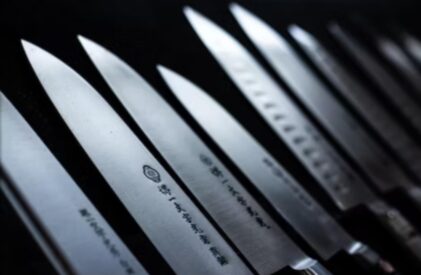Hello, dear readers!
We all love a great Japanese chef knife, don’t we? The way it glides through ingredients, transforming them from their raw form into delicious, ready-to-cook pieces, it’s simply magical. But have you ever wondered what gives these knives their legendary precision and durability? What are they made of, and why does it matter? Today, we’re going to delve deep into the materials that make up your beloved Japanese chef knife and understand why it’s truly a cut above the rest.
The Key Ingredient: Steel
The heart of any knife lies in its blade, and the blade’s heart, in turn, lies in its material. For Japanese chef knives, the material of choice is typically high-quality steel. However, it’s important to note that not all steels are created equal. The type of steel used significantly impacts the knife’s performance, including its sharpness, durability, and corrosion resistance.
Carbon Steel
Among the most commonly used materials for Japanese chef knives is carbon steel. Prized for its extreme hardness and sharpness, carbon steel knives offer exceptional precision and edge retention. However, they require a bit more care as they are prone to rust and discoloration if not properly maintained.
Stainless Steel
Another common material is stainless steel. It is lauded for its corrosion resistance and low maintenance requirements. However, stainless steel knives may not hold an edge as well as their carbon steel counterparts.
High-Speed Steel (HSP)
A newer player in the knife-making scene is high-speed steel (HSP). This steel type incorporates elements like tungsten and molybdenum, resulting in a blade that combines the best of both worlds – the sharpness of carbon steel and the rust resistance of stainless steel.
The Marriage of Steels: Laminated Blades
In the pursuit of the perfect blade, Japanese blacksmiths developed a technique known as lamination. This involves forging a knife using multiple layers of different steels. Typically, a harder, carbon steel core is enveloped by layers of softer, more resilient steel. This unique construction provides the knife with an incredibly sharp and durable edge while also offering a degree of flexibility and corrosion resistance.
Handle Matters: Beyond the Blade
The blade may be the star of the show, but let’s not forget the supporting actor – the handle. Japanese knife handles are typically made from wood, renowned for its comfort, durability, and aesthetic appeal.
The traditional ‘Wa’ handle is lightweight and offers an excellent grip, allowing for precision and control. Its simple, cylindrical design is made from a variety of woods like magnolia, sandalwood, or yew, sometimes supplemented with a water buffalo horn collar.
On the other end of the spectrum is the ‘Yo’ handle, a western-style design commonly found on hybrid Japanese knives. These are typically heavier and can be made from a range of materials, including wood, synthetic composites, or even stainless steel.
Wrapping Up
The making of a Japanese chef knife is a careful balance of materials, each chosen for their unique characteristics. The perfect steel for the blade, combined with the ideal handle material, creates a tool that is more than just a kitchen accessory – it’s a work of art.
Understanding the materials that go into your Japanese chef knife can enhance your appreciation for it. It allows you to understand why your knife performs the way it does and how to best care for it to ensure it lasts a lifetime.
We hope you found this deep dive into the materials of a Japanese chef knife enlightening. Stay tuned as we continue to unravel the wonderful world of Japanese chef knives!
In our next blog, we’ll be looking at the different types of Japanese chef knives and their uses in the kitchen. You won’t want to miss it!
